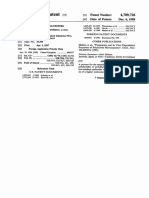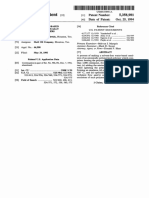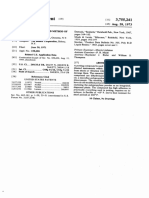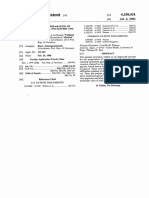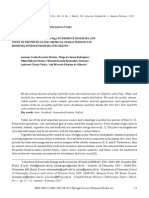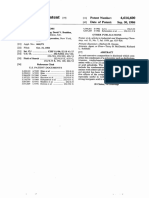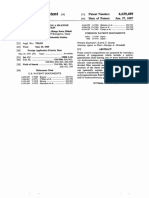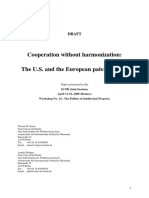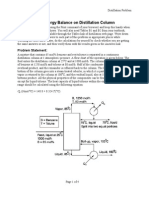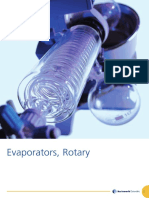0 ratings0% found this document useful (0 votes)
39 viewsRole - E.: United States Patent 19
Role - E.: United States Patent 19
Uploaded by
prasanThis patent describes linear, low-molecular-weight polyester-based polyols. The polyols are prepared through a transesterification reaction of methyl esters of aliphatic dibasic acids like adipic, glutaric and succinic acids with cyclohexane dimethanol. The reaction produces polyols with at least two hydroxyl groups, low viscosity, high solids content, and the given structural formula. The polyols can be used in coating compositions with cross-linking agents and resins.
Copyright:
© All Rights Reserved
Available Formats
Download as PDF, TXT or read online from Scribd
Role - E.: United States Patent 19
Role - E.: United States Patent 19
Uploaded by
prasan0 ratings0% found this document useful (0 votes)
39 views6 pagesThis patent describes linear, low-molecular-weight polyester-based polyols. The polyols are prepared through a transesterification reaction of methyl esters of aliphatic dibasic acids like adipic, glutaric and succinic acids with cyclohexane dimethanol. The reaction produces polyols with at least two hydroxyl groups, low viscosity, high solids content, and the given structural formula. The polyols can be used in coating compositions with cross-linking agents and resins.
Original Description:
Pol
Original Title
Us 4922002
Copyright
© © All Rights Reserved
Available Formats
PDF, TXT or read online from Scribd
Share this document
Did you find this document useful?
Is this content inappropriate?
This patent describes linear, low-molecular-weight polyester-based polyols. The polyols are prepared through a transesterification reaction of methyl esters of aliphatic dibasic acids like adipic, glutaric and succinic acids with cyclohexane dimethanol. The reaction produces polyols with at least two hydroxyl groups, low viscosity, high solids content, and the given structural formula. The polyols can be used in coating compositions with cross-linking agents and resins.
Copyright:
© All Rights Reserved
Available Formats
Download as PDF, TXT or read online from Scribd
Download as pdf or txt
0 ratings0% found this document useful (0 votes)
39 views6 pagesRole - E.: United States Patent 19
Role - E.: United States Patent 19
Uploaded by
prasanThis patent describes linear, low-molecular-weight polyester-based polyols. The polyols are prepared through a transesterification reaction of methyl esters of aliphatic dibasic acids like adipic, glutaric and succinic acids with cyclohexane dimethanol. The reaction produces polyols with at least two hydroxyl groups, low viscosity, high solids content, and the given structural formula. The polyols can be used in coating compositions with cross-linking agents and resins.
Copyright:
© All Rights Reserved
Available Formats
Download as PDF, TXT or read online from Scribd
Download as pdf or txt
You are on page 1of 6
United States Patent 19 11 Patent Number: 4,922,002
Calbo, Jr. et al. (45. Date of Patent: May 1, 1990
54) LINEAR, LOW-MOLECULAR-WEIGHT 4,119,976 10/1978 Anderson et al. .............. 528/254 X
POLYESTERBASED POLYOL 4,192,826 3/1980 Beresniewicz et al - - 525/425
4,222,911 9/1980 Christenson et al. ............ 528/295.5
75 Inventors: Leonard J. Calbo, Jr., Bethel; 4,284,750 8/1981 Amirsakis N. a 528/79
Lawrence V. Gallacher, East Primary Examiner-Werren B. Lone
Norwalk, both of Conn. Assistant Examiner-Vera C. Clarke
73) Assignee: King Industries, Inc., Norwalk, Attorney, Agent, or Firm-Hedman, Gibson, Costigan &
Conn. Hoare
21 Appl. No.: 355,164 57 ABSTRACT
22 Filed: May 22, 1989 This invention relates to certain linear, low-molecular
weight polyester-based polyols having at least two hy
Related U.S. Application Data droxyl groups, low viscosity, high solids content and
having the structural formula:
63 Continuation of Ser. No. 684,737, Dec. 21, 1984, Pat.
No. 4,888,441, which is a continuation-in-part of Ser.
No. 453,222, Dec. 27, 1982.
51l Int. Cl. .............................................. CO7C 69/34
52 U.S. C. .................................... 560/193; 524/314;
560/80; 560/84; 560/90; 560/182; 560/198;
role---------e. O O
I
560/204 wherein R is a moiety derived from a saturated aliphatic
58 Field of Search ................................ 560/193, 198 polyhydric alcohol; n is 1 or 2, and at least about 50%
56) References Cited by weight, of n is n=1; p is 0 to 4 inclusive and m is 2
U.S. PATENT DOCUMENTS
to 10 inclusive; said polyol being substantially free of
any unreacted polyhydric alcohol.
4,000,214 12/1976 Lum et al. ...................... 52.5/528 X
4,018,848 4/1977 Khanna ........................... 527/314 X 10 Claims, No Drawings
4,922,002
1. 2
one can use limited amounts of the aromatic dibasic or
LINEAR, LOW-MOLECULAR-WEIGHT tribasic acids whether they are monoaromatic acids
POLYESTER-BASED POLYOL such as o-, m-, or p-phthalic acids, mellitic acid and the
like including their anhydrides wherever available or
This is a continuation of application Ser. No. their lower alkyl esters or the polyaromatic dibasic
06/684,737, filed Dec. 21, 1984, now U.S. Pat. No. acids such as naphthalic acids and the like. When the
4,888,441, which is a continuation-in-part of Ser. No. aromatic acids are used, they must be used with one or
06/453,222, filed on Dec. 27, 1982. more linear aliphatic dicarboxylic acids and in amounts
BACKGROUND OF THE INVENTION less than the amount of the aliphatic acids. In fact, the
O aromatic acids, when used, should be present in an
This invention is in the field of certain linear, low amount not exceeding about 30 mole percent based on
molecular-weight polyester-based polyols having at the total moles of aromatic and aliphatic acids used and
least two hydroxyl groups, comparatively low viscosi preferably not exceeding about 10 mole percent, same
ties and comparatively high solids contents. This inven basis, for most purposes.
tion is also in the field of coating compositions contain 15 The methyl esters of these dibasic acids, sometimes
ing these polyols with a cross-linking agent such as referred to as dibasic esters, are mixed with one or more
aminotriazine compounds and resins such as melamine polyhydric alcohols containing at least two alcoholic
formaldehyde resins, urea-formaldehyde resins, epoxy hydroxyl groups of which at least one hydroxyl group
resins, isocyanates or acrylic polymers containing reac is a primary hydroxyl group. The preferred diol is cy
tive groups, such as hydroxyl groups, carboxyl groups, 20 clohexane dimethanol, CHDM, for brevity. Examples
amide groups, amine groups and the like. of other polyhydric alcohols with primary hydroxyls
THE PRIOR ART that could be used include neopentyl glycol; 1,4-
butanediol; 1,6-hexanediol; 2,2,4-trimethyl 1,3 pentane
The instant applicants are aware of the following diol; 1,2,6-hexanetriol; trimethylol ethane; trimethylol
U.S. Pat. Nos. 4,018,848; 4,119,762; 4,222,911; and Brit- 25 propane; pentaerythritol, dipentaerythritol, sorbitol,
ish 1,561,076, all of which patents are incorporated mannitol; dimethylolpropionic acid; and 2,2-dimethyl
herein by reference. 3-hydroxypropyl-2,2-dimethyl-3-hydroxypropionate
DESCRIPTION OF THE INVENTION and the like. Diols containing a mixture of primary and
secondary hydroxyls may be used, and include propy
This invention relates to linear, low-molecular- 30 lene glycol and 1,2-hexylene glycol. Mixtures of other
weight, polyester-based polyols having at least two diols may also be used.
hydroxyl groups, a comparatively low viscosity, and a Usually a catalyst is employed for the esterification/-
comparatively high solids content. The invention also transesterification reaction for the purpose of lowering
relates to a process for the preparation of said polyols. reaction temperatures and reducing color development
The polyols of the present invention can be prepared by 35 in the product. Typical catalysts that may be employed
transesterifying a mixture of the alkyl esters of aliphatic are the alkoxides of titanium, soluble tin compounds
dibasic acids, sometimes referred to herein as dicarbox such as dibutyl tin dilaurate and soluble manganese
ylic acids, or simply esterifying a mixture of said acids compounds such as Mn(OAc)2. Catalyst levels of 0.005
with one or more of certain polyhydric alcohols. It is to 1.0% by weight of the reactants can be used or typi
preferred to start with the methyl esters of dicarboxylic 40 cal levels of 0.01 to 0.5% on the same basis can be used.
acids such as adipic, glutaric and/or succinic acids al In the preferred embodiment, the mixed methyl esters
though other lower alkyl esters could be used, such as are combined with CHDM in a suitable reaction vessel
the ethyl, propyl and butyl esters and the like, but cost and heated in the presence of a conventional transesteri
factors generally remove these higher esters from con fication catalyst, such as a titanium alkoxide, in order to
sideration since nothing of value is to be gained by their 45 accomplish transesterification. The methanol is split off
use. Furthermore, this mixture of methyl esters is avail during the heating step and is easily removed as free
able commercially and is therefore additionally pre methanol until the new reaction product is devoid of or
ferred, for this reason. These methyl esters, as available substantially completely free of methanol. The resultant
commercially, have a mole ratio of about 0.5:1.5:0.6, product will contain, as a general rule, some varying
dimethyl adipate, dimethyl glutarate and dimethyl suc 50 amounts of unreacted cyclohexane dimethanol depend
cinate respectively. Variations of this mole ratio can be ing on the initial mole ratio of the reactants. The initial
tolerated depending upon the desired properties of the starting mole ratios of the dimethyl esters, also referred
final product. Lower viscosities are obtainable with to as dibasic esters, considered as a whole and as one
higher levels of glutarate, for example. It is not neces entity, to the cyclohexane dimethanol can be varied
sarily limited, for instance, to a mixture of these three 55 between about 1.0:1.5 and 1.0:10.0 respectively, di
recited esters. It is also possible to use mixtures of only methyl esters to CHDM, but preferably between about
two dibasic acid esters or even a single dibasic ester if 1.0:2.0 and 1.0:4.0 respectively, dimethyl esters to
desired. The same would apply to the dibasic acids and CHDM.
their anhydrides wherever available as well, such as The ultimately produced polyol will be devoid of or
mixtures of the acid compounds or single compounds if 60 substantially completely free of any cyclohexane dime
desired. The dibasic acids that can be used include suc thanol. The expressions, devoid of or substantially com
cinic, glutaric, adipic, pimelic, suberic, axelaic, sebacic, pletely free of, means less than about 12% and prefera
tartaric and the like including the higher homologs or bly less than about 4% by weight based on the total
mixtures thereof. Additionally, one can use tribasic weight of the final polyol reaction product.
acids such as citric or tricarballylic acid. However, 65 The conventional technique used to remove the unre
these tribasic acids should be used in combination with acted diol is batch distillation. The preferred technique
the dibasic acids and generally in less than 50 mole uses continuous rapid stripping of the CHDM or other
percent based on the total moles of acid. Additionally, alcoholic reactant, immediately followed by cooling the
3
4,922,002
4.
product to prevent chemical reaction and equilibration. achievable when all of the reactive groups have equal
Continuous large-scale rapid stripping can be accom chemical reactivity. Thus, a diol with one primary and
plished using several processes including continuous one secondary hydroxyl group will naturally yield a
column distillation, shell-and-tube evaporators and fall diester high in secondary hydroxyls, because the prima
ing-film evaporator-strippers, to name several examples. ries will have reacted first to form the diester. Further,
It is conceivable that other techniques could be applied it will be much harder to get chain extension once one
to remove excess diol, including liquid-liquid extraction has diester, since the secondary hydroxyl end groups
or crystallization. are not very reactive. In a case like this, one would be
A useful laboratory technique to demonstrate the able to get a good yield of diester starting with a low
importance of rapid stripping and immediate cooling 10 diol:acid ratio, not much over 2:1. Following the same
utilizes a rotary evaporator and an oil bath. The charge line of reasoning, one should be able to remove excess
is a mole ratio of 1:3, dibasic acid to cyclohexane dime diol molecules easily without significant chain exten
thanol transesterification product into the rotary evapo sion, so it should be possible to get extremely high
rator at an absolute pressure of 1-2 Torr and an oil bath solids.
temperature of 180°-185° C. for eight minutes. 43% of 15 In one embodiment, a wiped-film evaporator is used
the charge is volatilized and the resultant product has a to accomplish the rapid stripping of the CHDM.
viscosity of 13,800 cps, at 25 and a 60 minutes solids A wiped-film evaporator, such as the Artisan Roto
content of 98.8%. therm (R) thin-film evaporator consists of a heated cylin
If one were to use the batch distillation technique, drical chamber with a feed inlet at the top above a
one experiences high viscosity and low solids content. 20 rotatable heated cylindrical member or rotor onto
The reason for these adverse results may reside in the which the feed flows, maintaining the feed as a thin film
fact that the product is equilibrating chemically toward on the inner wall of the cylindrical chamber. A top exit
the most probable component distribution during the is provided for the CHDM vapor to escape. An outlet is
slow batch distillation. Actually, polyesterification re provided at the bottom from which the desired polyol
actions and transesterification reactions such as this 25 product emerges. The rotor is attached to an electric
always lead to equilibrium product distributions dic motor which provides the rotation. The temperature of
tated by simple statistical considerations. Therefore, a the heated film is about 350 F. and the absolute pres
batch distillation of a high glycol-to-acid polyol to a sure is about 2 mm. The residence time of the material
lower glycol/acid mole ratio may tend to give the same being treated varies from about 30 seconds to 2 minutes.
equilibrium product one would obtain by running the 30 The product leaving at the outlet passes through a heat
whole transesterification reaction at the final mole ratio. exchanger which cools it to approximately 200 F. be
The expression, "Low Viscosity', as used herein fore it flows into the product storage vessel.
above and as applied to the products of the present The polyols of the present invention can be used as
invention, means viscosities of not more than about coating compositions without modification when com
15,000 cps and preferably not more than about 10,000 35 bined with any one or more of a host of crosslinking
cps when measured on a substantially 100% solids mate agents, such as polyisocyanate or the aminotriazine
rial at 25 C. However, when aromatic polycarboxylic aldehyde such as the melamine-formaldehyde resins and
acids are used as one of the acidic compounds, these the like. One can also use the acrylic co-polymers con
viscosities will be higher, such as 30,000 cps or even taining alcoholic hydroxy groups in conjunction with
higher. The viscosities are, in fact, low when compared the polyols of the present invention and crosslinking
with the viscosities of similar polyols that are prepared agents with or without other reactive groups such as
by processes that are outside of the scope of the process carboxy groups, amide groups, amine groups and the
of the present invention even though these similar poly like as shown in the U.S. Pat. Nos. 3,663,389, 3,894,993,
ols contain substantially the same reactants and contain and 3,945,961. These patents are incorporated herein by
substantially the same amounts of each reactant on a 45 reference.
mole/mole basis. - Other conventional additives may also be used such
Although one of the principal uses of the polyols of as pigments, catalysts, and the like.
the present invention is in coating compositions, one In order that the concept of the present invention
may use these polyols in such areas as adhesives, foams, may be more completely understood, the following
moldings, elastomers, and laminates with whatever 50 examples are set forth in which all parts are parts by
modifications may be required and such further addi weight unless otherwise indicated. These examples are
tives as fillers, layers, and the like. set forth primarily for the purpose of illustration and
Surprisingly, it was found that rapid stripping of a 3:1 any specific enumeration of detail contained herein
mole ratio CHDM:dibasic ester polyester polyol feed should not be interpreted as a limitation on the case
followed by rapid cooling removed approximately 35% 55 except as is indicated in the appended claims.
of the total weight offeed as CHDM and gave products EXAMPLE 1.
which combined both low viscosity, on the order of
10,000 cps at 25 C., and high solids content, on the Into a suitable glass reactor, the following ingredients
order of 98%. In contrast, conventional batch distilla were charged:
tion removing the same weight of CHDM with or with 98.27 parts CHDM (309.6 moles)
out rapid-cooling gives products with much higher 7.37 parts Dibasic esters (20.9 moles)
viscosities, on the order of 19,000 cps or higher at 25 Using a mantle, the contents of the reactor were heated
C., and lower solids content, on the order of 90%. to 125 C. with agitation, and then 12.3 parts of titanium
These properties are extremely important in the formu tetrabutoxide were added. Heating was continued while
lation, application, and performance of high-solids coat 65 a nitrogen flow of 100 ml/min. into the reactor was
ings, as will be shown elsewhere in this application. maintained. When the temperature reached 160" C., the
In principal, the same technique is applicable to other temperature was maintained at that level, and 29 parts
ester polyols as well. The maximum positive effect is of dibasic esters (82.2 moles) were then metered into the
4,922,002
5 6
reactor over a 3 hour period with continuous agitation. The coating mix is applied by draw down bar to iron
During the dibasic esters addition period, methanol phosphated cold rolled steel and cured for 20 min. at
vapor was evolved continuously and condensed with a 150° C. in a forced draft convection oven. The proper
water-cooled glass condenser to recover 7.4 parts of ties are set forth hereinbelow.
liquid methanol. 5
This product was then processed in a 1 square foot
Artisan Rototherm wiped-film evaporator. The feed 2 3
rate was set at 19 ml per minute with a product outlet Pencil Hardness 2-3H 4-5H 2-3H
temperature of 175' C. at a pressure of approximately 1 Double MEK Rubs 100- 100-- 100
torr. The product was passed through a cooled outlet 10 Adhesion Loss, 26
Impact.
0 O O
pipe to adjust the final product temperature to 95 C. everse 30-40 80- 80--
The finished product had a viscosity of 9000 cps at 25 direct 80- 80- 70/80
C. and showed 98% solids content in a one hour test. Water Immersion Few 8 Very Few 8 Very Few 8
The following examples are illustrative of the utility 250 hr, 50° C.
15 Blister Rating
of the present invention:
EXAMPLE 2
A coating composition is prepared by mixing the EXAMPLE 4
following ingredients: In this example a pigmented enamel is prepared by
20
grinding titanium dioxide in a polyol of the present
Formulation Parts invention. The enamel thus prepared has very high
Polyol from Example 1 60 solids and excellent low temperature cure properties as
Hexakis (methoxymethyl) melamine() 40 illustrated herein below.
n-Butanol 10 25
Flow control agent() 0.4
Acid catalyst() 2 Mix in a suitable container:
% Solids = 89.5 Titanium dioxide 550 parts
Viscosity = 880 cps Polyol of Example 1 250
Cymel 303, American Cyanamid Company n-Butano 75
3M Co. (a fluorocarbon) 30 Celosolve Acetate 25
King Industires, Inc. - DNNDSA Disperse on Cowles Dissolver
Let Down
The coating is applied by draw down bar to yield Acrylic Resin()
Hexakis(methoxymethyl)melamine()
333
200
approximately 1 mil film thickness on a phosphate n-Butanol 30
treated steel panel which is then placed in a forced draft 35 % Solids, wit 80
convection oven and cured under the following several Viscosity, cps 440
conditions of varying time and temperature: Polyoi/Acrylic/Melamine Wt. Ratio 50/50/40
Film Properties White Enamel
Time, min. 20 15 O 5 Cure:
Temp, F. 200 225 250 275 40 Time, min. 15 5 30
Pencil Hardness H-2H H-2H H-2H H-2H Temp., C. 2 93 82
Double MEK Rubs 100 00 100 100 Catalyst: DNNDSA, 7% TRS 0.6 2.0 2.75
Reverse Impact, in lb. 80-- 80- 80- 80 Pencil Hardness 2-3H H-2H H-2H
MEK Rubs 200 200 170
45 Reverse Impact 80-- 80-- 80--
Gloss, 60 89 9 9.
EXAMPLE 3 Water Immersion 89 90 86
The following example illustrates the improved coat 250 hr., 50° C.
Gloss. 60
ing properties that result when a polyol of the present TRS - Total Resin Solids
invention is used as a minor component of the binder 50 King Industries, Inc.
system. Cymel 303, American Cyanamid Co.
The ingredients listed below are blended in a suitable
container.
EXAMPLE 5
Formulation 1. 2 3 55 A room temperature curing coating composition is
Acrylic Resin() 200 280 240
prepared by mixing the polyol of Example 1 with an
Hexakis(methoxymethyl) 25 50 60 isocyanate crosslinking agent in the manner described
melamine(2) below.
Polyol of Example - O 20
Isopropanol 25 42 44
Xylene - 18 36 Components Parts
DNNDSAG3) Amine 2.5 4.0 4.0
Blocked Polyol of Example 1 100
Catalyst Polyisocyanate() 82
Acrylic/Melamine/Polyol 80/20/- 70/25/5 60/30/10 Xylene 30
Wt. Ratio 2-Ethoxyethyl Acetate 30
65 % Solids = 75
Rohm & Haas Co.
cymel 303, American Cyanamid Co. Viscosity = 60 sec. Ford 4 Cup
King Industries, Inc. Mobay Chemical Corp.
4,922,002
7 8
The coating may be either sprayed or applied by temperature of 224 C. and generating 46 parts of distil
draw down bar to a steel panel with the resultant film late.
properties. The intermediate product had a solids content of
95%. After stripping in a rotary evaporator at 250 C.
After 24 hr. aging of the coated panel at room temperature:
5 and 1.6 torr, the resulting product showed a solids con
Pencil Hardness 5-6H
tent of 100% and a viscosity of 11,500 cps at 25 C.
MEK Rubs 200 EXAMPLE 8
Impact.
reverse 60 in. ib. 10 This example shows the use of neopentylglycol and
direct 60 in, lb. dibasic esters to prepare the product of this invention.
To a suitable stainless steel reactor was charged 409
Coating is tack-free after 6 hours. parts of dibasic ester. The agitator was started and then
400 parts of neopentyl glycol were charged.
EXAMPLE 6 5 Steam heat was then applied to the jacket to raise the
The following ingredients were charged into a suit contents of the reactor to 140 F. to dissolve the neo
able glass reaction vessel: pentylglycol. Then an additional 400 parts of neopentyl
270.4 parts 1,4-Butanediol (3.0 moles) glycol was added and heating was continued. When the
160.0 parts Dibasic Esters (1.0 mole) batch temperature reached 200' F., 3 parts of dibutyltin
Using a heating mantle and agitator the contents of 20 dilaurate were added.
the flask were heated to 125 C., and then 1.77 parts of Heating was continued with agitation. Methanol
titanium tetrabutoxide were added. Heating was contin began distilling over at 300 F. After an additional 3
ued, and at 137 C. methanol began distilling over and hours, the temperature had risen to 335 F. and metha
was recovered continuously with a water-cooled total nol evolution stopped. At this point 151 parts of con
condenser. Three hours and twenty minutes after the 25 densed methanol had been collected. The batch temper
start of the experiment, the temperature was 176 C. and ature was maintained at 325-335 F. for an additional
the evolution of methanol appeared to be over, with 54 hour under a nitrogen sweep of 10 scfm. The batch was
parts of condensate collected. then cooled to 200 F. and drummed prior to stripping.
The intermediate product at this point was checked Evaluation of this intermediate product showed a
for solids content using a modified ASTM D-2369-81-B 30 65% solids content when tested in accordance with the
procedure: Obtain the tare weight "T" of a 58 mm procedure of Example 6. The material was stripped
aluminum weighing dish containing a paper clip and using a wiped-film evaporator with a preevaporator
record to the nearest 0.1 mg. Add 0.5-0.1 g of sample stage and rapid product quenching. A maximum tem
using a syringe and record sample weight "S" to nearest perature of 365' F. at 150 torr produced a final product
0.1 mg. Add 2-0.2 g of toluene, mix contents with 35 with a measured solids content of 96.0% and a viscosity
paper clip until homogeneous, and finally place paper of 3720 cps at 25° C.
clip in dish. Heat the dish and contents in a forced draft In the polyols of the present invention, the amount of
oven for 60 minutes at 110' C. Cool in a desiccator to the bracketed moiety, where n is 1 or 2, is at least about
ambient temperature and weight dish and contents to 50% by weight of n = 1 and m is 2 to 10 inclusive. It is
nearest 0.1 mg (weight "F"). Determine percent solids 40 preferred that such moiety is sufficient to provide an
as follows and report to nearest 0.1%: average molecular weight of between about 300 and 600
and preferably between about 350 and 500. The final
reacted mole ratio of the dibasic acid to the polyhydric
% Solids = -100XF - D - alcohol is between about 1.0:1.3 and 1.0:2.4 respectively
45 and preferably between about 1.0:1.5 and 1.0:2.1 respec
The solids content was found to be 68.9% using this tively.
test. This test is and has been used to determine solids The process of the present invention requires a strip
content throughout this specification. ping temperature of from about 150° C. to 225° C. at an
The intermediate product was then stripped on a absolute pressure of from about 0.05 to 200 torr for a
rotary evaporator for 10 minutes at 201 C. and 2.5 torr 50 period of time from about 10 seconds to 10 minutes.
and quickly cooled to room temperature. The final It is preferred to use a temperature from about 160'
product so produced had 98.3% solids following the C. to 210 C. at an absolute pressure of from about 0.1
above test procedure, and a viscosity of 4500 cps at 25 to 150 torr for a period of time from about 20 seconds to
C. about 2 minutes.
55 We claim:
EXAMPLE 7
1. A linear, low-molecular-weight polyester-based
This example illustrates the use of a trihydric alcohol polyol having at least two hydroxyl groups, low viscos
to prepare the product of this invention. ity, high solids content and having the structural for
The following ingredients were charged into a suit mula:
able glass reaction vessel set up with a heating mantle, 60
stirrer, total condenser, and thermometer:
275.7 parts 1,2,6-Hexanetriol (2.055 moles)
109.6 parts Dibasic Esters (0.685 mole)
The mantle was then used to heat the contents of the
flask while agitating. At 122 C. batch temperature, 1.58 65
parts of titanium tetrabutoxide was added, and heating wherein R is a moiety derived from saturated aliphatic
was continued. Methanol began distilling over at 170 polyhydric alcohol; n is 1 or 2, and at least about 50%
C. The reaction was over in 2 hours, reaching a peak by weight of n is n = 1; p is 0 to 4 inclusive and m is 2 to
4,922,002
10
10 inclusive; said polyol being substantially free of any 6. The polyol according to claim 3 in which the poly
unreacted polyhydric alcohol. hydric alcohol is cyclohexane dimethanol.
2. A polyol according to claim 1 in which the moiety 7. The polyol according to claim 1 in which m=2 to
R is derived from cyclohexane dimethanol. 4 inclusive.
3. A polyol according to claim 1 in which the mole 8. The polyol according to claim 7 in which the mole
ratio of the dibasic acid to the polyhydric alcohol is ratio of the dibasic acid to the polyhydric alcohol is
between about 1.0:1.3 and about 1.0:2.4 respectively. between about 1.0:1.3 and 1.0:2.4 respectively.
4. A polyol according to claim 1 in which the moie 9. The polyol according to claim 7 in which the aver
age molecular weight of said polyol is between about
ratio of the dibasic acid to the polyhydric alcohol is 10 300 and 600.
between about 1.0:1.5 and 1.0:2.1 respectively. 10. The polyol according to claim 7 in which the
5. The polyol according to claim 1 in which the aver mole ratio of the dibasic acid to the polyhydric alcohol
age molecular weight of said polyol is between about is between about 1.0:1.5 andk 1.0:2.1 respectively.
300 and 600. is :
15
20
25
30
35
40
50
55
60
65
You might also like
- Oxygen Plant Project ReportDocument23 pagesOxygen Plant Project ReportAnwar Ahmad100% (1)
- Andrew Norton Webber - Distilled WaterDocument15 pagesAndrew Norton Webber - Distilled Wateriguandián88% (8)
- Astm C 497 PDFDocument9 pagesAstm C 497 PDFSerdarYumuk100% (2)
- Astm D86Document27 pagesAstm D86dennise8100% (1)
- Unsat Pol EsterDocument9 pagesUnsat Pol EsterAmr Abdelmegid abdelsalam husseinNo ratings yet
- United States Patent (19) : Hopkins Et Al. Aug. 13, 1985Document4 pagesUnited States Patent (19) : Hopkins Et Al. Aug. 13, 1985choloqfNo ratings yet
- United States Patent (19.: 54) - Stabilizer System For CommercialDocument4 pagesUnited States Patent (19.: 54) - Stabilizer System For CommercialcholoqfNo ratings yet
- US4235766Document5 pagesUS4235766هیمن مNo ratings yet
- Process For Preparing PolyesterDocument8 pagesProcess For Preparing PolyesterAnh Đức PhạmNo ratings yet
- United States Patent (19) : Argento Et AlDocument11 pagesUnited States Patent (19) : Argento Et AlSoh Ming LunNo ratings yet
- US4220568 Patton's ConstantDocument10 pagesUS4220568 Patton's ConstantSUBRAMANIAN SNo ratings yet
- US4818795Document8 pagesUS4818795UtpalNo ratings yet
- United States PatentDocument5 pagesUnited States Patentهیمن مNo ratings yet
- United States Patent (191: Gardiner Et AlDocument7 pagesUnited States Patent (191: Gardiner Et Alvzimak2355No ratings yet
- US20040024101A1Document31 pagesUS20040024101A1SUBRAMANIAN SNo ratings yet
- US3915936Document6 pagesUS3915936rajesh kothariNo ratings yet
- Umted States Patent (19) (11) Patent Number: 4,789,726: Hutchinson (45) Date of Patent: Dec. 6, 1988Document5 pagesUmted States Patent (19) (11) Patent Number: 4,789,726: Hutchinson (45) Date of Patent: Dec. 6, 1988Citra Adelina SitorusNo ratings yet
- US4798876 Hydrophilic PU CompositionDocument4 pagesUS4798876 Hydrophilic PU CompositiondangcongsanNo ratings yet
- Method of Hydrolyzing PolyacrylamideDocument5 pagesMethod of Hydrolyzing PolyacrylamidePutri Nadya KamilaNo ratings yet
- AcetyladipicdihydrazideDocument5 pagesAcetyladipicdihydrazideanandgoalNo ratings yet
- Paten US4223163Document7 pagesPaten US4223163rahmanNo ratings yet
- US4882397Document19 pagesUS4882397MorkizgaNo ratings yet
- Articulo 4Document6 pagesArticulo 4Daniel QuinteroNo ratings yet
- United States Patent (19) : SouthwickDocument6 pagesUnited States Patent (19) : SouthwickEdgar hernandezNo ratings yet
- Mark F. Dante - Stable Epoxy-Amine Curing Agent AdductDocument6 pagesMark F. Dante - Stable Epoxy-Amine Curing Agent Adductmat81tiaNo ratings yet
- US3945843Document3 pagesUS3945843rajesh kothariNo ratings yet
- Patente Fenolica Con Butanol US4120847Document8 pagesPatente Fenolica Con Butanol US4120847Jose LopezNo ratings yet
- United States Patent (19) : Daly Et Al. 11) 4,436,836Document9 pagesUnited States Patent (19) : Daly Et Al. 11) 4,436,836arif thoha bariklanaNo ratings yet
- US4094913Document4 pagesUS4094913Ranjana MadabushiNo ratings yet
- United States Patent (191Document11 pagesUnited States Patent (191Sushil Kumar RaoNo ratings yet
- United States Patent (19) : Brady (45) Aug. 28, 1973Document4 pagesUnited States Patent (19) : Brady (45) Aug. 28, 1973Vansala GanesanNo ratings yet
- United States Patent (191: Vcudmore (45) Date of Patent: Mar. 25, 1986Document6 pagesUnited States Patent (191: Vcudmore (45) Date of Patent: Mar. 25, 1986Rafael V. Tolentino HdzNo ratings yet
- Us 4338431Document4 pagesUs 4338431SUBRAMANIAN SNo ratings yet
- United States Patent (19) (11) Patent Number: 5,271,824: Forester Et Al. (45) Date of Patent: Dec. 21, 1993Document5 pagesUnited States Patent (19) (11) Patent Number: 5,271,824: Forester Et Al. (45) Date of Patent: Dec. 21, 1993aegosmithNo ratings yet
- CURRENT PROBLEMS. Alternative Fuels: Use of Baru Oil (Dipteryx Alata Vog.) TO PRODUCDocument4 pagesCURRENT PROBLEMS. Alternative Fuels: Use of Baru Oil (Dipteryx Alata Vog.) TO PRODUCAntonio Carlos Flash BatistaNo ratings yet
- US5102977 - Internally Catalyzed Sulfonate Bearing Hydroxyl Terminated Powder Coating Polyesters - Ruco Polymer Corp.Document13 pagesUS5102977 - Internally Catalyzed Sulfonate Bearing Hydroxyl Terminated Powder Coating Polyesters - Ruco Polymer Corp.SUBRAMANIAN SNo ratings yet
- United States Patent (19) : Charleston, Both of W. Va.Document10 pagesUnited States Patent (19) : Charleston, Both of W. Va.andari yuta palwaNo ratings yet
- US4115424Document6 pagesUS4115424Muhammad Akbar FahleviNo ratings yet
- US3891683Document5 pagesUS3891683Risma Dewi SNo ratings yet
- Macromolecular Symposia - 2016 - Muniz Wypych - Poly Alkyl Acrylates As Pour Point Improvers For BiofuelsDocument9 pagesMacromolecular Symposia - 2016 - Muniz Wypych - Poly Alkyl Acrylates As Pour Point Improvers For BiofuelsAustin SmithNo ratings yet
- US4133786Document5 pagesUS4133786Ilham Kiki ShahilaNo ratings yet
- Lambda + Chlorantraniliprole - Cómo Estabilizar La SuspensiónDocument8 pagesLambda + Chlorantraniliprole - Cómo Estabilizar La SuspensiónAlfredo MéndezNo ratings yet
- Us 3717672Document5 pagesUs 3717672eschim.civNo ratings yet
- Biodiesel and Renewable DieselDocument10 pagesBiodiesel and Renewable DieselBhavana Singh0% (1)
- Us4018815 PDFDocument4 pagesUs4018815 PDFFatih AkmanNo ratings yet
- United States PatentDocument3 pagesUnited States PatentSmokeNo ratings yet
- Article: Cr/Al Oxide As Solid Acid Catalyst To Afford Babassu BiodiselDocument11 pagesArticle: Cr/Al Oxide As Solid Acid Catalyst To Afford Babassu BiodiselLiz PonceNo ratings yet
- Us 5317036Document21 pagesUs 5317036Sushil Kumar RaoNo ratings yet
- Lipase-Catalyzed Production of BiodieselDocument5 pagesLipase-Catalyzed Production of BiodieselTirth_Panchal_6929No ratings yet
- WaigFang 23262Document9 pagesWaigFang 23262Dipak PatelNo ratings yet
- 2-12-23 Prepare Latent Curing Agent For PUaDocument8 pages2-12-23 Prepare Latent Curing Agent For PUaQuynh HoangNo ratings yet
- US4614600Document9 pagesUS4614600Lab. Petroleo AGENANo ratings yet
- United States Patent (19) : Jun. 9, 1987 11) Patent Number: (45) Date of PatentDocument5 pagesUnited States Patent (19) : Jun. 9, 1987 11) Patent Number: (45) Date of Patentnelson bessoneNo ratings yet
- Patent 2 Pabrik Phenyl Ethyl AlcoholDocument5 pagesPatent 2 Pabrik Phenyl Ethyl AlcoholFaizhal DimazNo ratings yet
- US4582892Document8 pagesUS4582892Sayyed Abdul QayyumNo ratings yet
- US5399752Document8 pagesUS5399752soorenaNo ratings yet
- Us 4639489Document7 pagesUs 4639489Pat22 22patNo ratings yet
- Ar Reodorant CompositionsDocument6 pagesAr Reodorant CompositionsDr CashNo ratings yet
- 5synthesis and Reactions of Unsaturated SugarsDocument65 pages5synthesis and Reactions of Unsaturated SugarsHung le VanNo ratings yet
- Patent On Peroxide Stablization AlkalineDocument5 pagesPatent On Peroxide Stablization AlkalineparagNo ratings yet
- Brassylic Acid PVCDocument4 pagesBrassylic Acid PVCSudha Raman-ShadakshariNo ratings yet
- US4207205Document7 pagesUS4207205yanger730No ratings yet
- US3926841Document5 pagesUS3926841Lê Thùy NgânNo ratings yet
- Five Member Heterocyclic Compounds with Nitrogen and Sulfur or Nitrogen, Sulfur and Oxygen (Except Thiazole)From EverandFive Member Heterocyclic Compounds with Nitrogen and Sulfur or Nitrogen, Sulfur and Oxygen (Except Thiazole)L. L. BambasNo ratings yet
- Icici Bank Limited: Company BackgroundDocument3 pagesIcici Bank Limited: Company BackgroundprasanNo ratings yet
- Retail Banking in A Digital WorldDocument46 pagesRetail Banking in A Digital WorldprasanNo ratings yet
- HSPQHZNEWDocument5 pagesHSPQHZNEWprasanNo ratings yet
- mEDBROUCHURE OPEN SOURCEDocument22 pagesmEDBROUCHURE OPEN SOURCEprasanNo ratings yet
- Fao Food and Nutrition PaperDocument79 pagesFao Food and Nutrition PaperprasanNo ratings yet
- CIMFDocument3 pagesCIMFprasanNo ratings yet
- Sample Question Paper Nutrition Class-XIDocument4 pagesSample Question Paper Nutrition Class-XIprasanNo ratings yet
- United States Patent (10) Patent No.: US 6,258,869 B1: Shah Et Al. (45) Date of Patent: Jul. 10, 2001Document4 pagesUnited States Patent (10) Patent No.: US 6,258,869 B1: Shah Et Al. (45) Date of Patent: Jul. 10, 2001prasanNo ratings yet
- Cooperation Without Harmonization: The U.S. and The European Patent SystemDocument29 pagesCooperation Without Harmonization: The U.S. and The European Patent SystemprasanNo ratings yet
- How To Apply For A Patent: A Guide For FIRST LEGO League Teams Entering The Global Innovation Award CompetitionDocument14 pagesHow To Apply For A Patent: A Guide For FIRST LEGO League Teams Entering The Global Innovation Award CompetitionprasanNo ratings yet
- Portico Ip AnalysisDocument7 pagesPortico Ip AnalysisprasanNo ratings yet
- Discussion Cooling TowersDocument2 pagesDiscussion Cooling TowersHanny100% (1)
- PELAYO - PHYCHEM LAB II EXP1to5 - 730 - 1030 - FridayDocument19 pagesPELAYO - PHYCHEM LAB II EXP1to5 - 730 - 1030 - FridayJv Dordas PelayoNo ratings yet
- Gold ReportDocument25 pagesGold ReportAhmed FityanNo ratings yet
- Determination of Moisture Content (AOAC 1970) : Flowchart Attachment 1Document8 pagesDetermination of Moisture Content (AOAC 1970) : Flowchart Attachment 1Zulvava AbidahNo ratings yet
- Final Year Project On Tilapia Fish FilletDocument66 pagesFinal Year Project On Tilapia Fish FilletaidasyazaNo ratings yet
- Worksheets Bpo HycDocument71 pagesWorksheets Bpo HycHrithik JerathNo ratings yet
- Advanced Method of Secondary Metabolite Extraction and Quality AnalysisDocument14 pagesAdvanced Method of Secondary Metabolite Extraction and Quality AnalysisroopashreeNo ratings yet
- Types of Trays The Packing MaterialDocument5 pagesTypes of Trays The Packing Materialaly100% (1)
- Qualitative Organic Analysis PDFDocument75 pagesQualitative Organic Analysis PDFAbhi RamNo ratings yet
- Experiment 1 Solid Liquid ExtractionDocument6 pagesExperiment 1 Solid Liquid ExtractionDivaan Raj Karunakaran0% (1)
- Literatur Modul 5 - Kesetimbangan FasaDocument18 pagesLiteratur Modul 5 - Kesetimbangan Fasasherilyn pagarintanNo ratings yet
- Wood 1973Document11 pagesWood 1973pyimNo ratings yet
- Energy Balance On Distillation ColumnDocument4 pagesEnergy Balance On Distillation ColumnCecilia Tan70% (10)
- Elite BrandsDocument3 pagesElite Brandsmanishcfa@yahoo.co.inNo ratings yet
- Fundamental Modeling and Simulation of A Binary Continuous Distillation ColumnDocument5 pagesFundamental Modeling and Simulation of A Binary Continuous Distillation ColumngesegsgsNo ratings yet
- Distillation Column ReportDocument6 pagesDistillation Column Reportjuan francoNo ratings yet
- Hydroprocessing DepropanizerDocument12 pagesHydroprocessing DepropanizerSathish KumarNo ratings yet
- 1st Year D.Pharm SyllabusDocument12 pages1st Year D.Pharm SyllabusBhawesh JhaNo ratings yet
- Preparation of Zeolite Y Catalyst For Petroleum CrackingDocument7 pagesPreparation of Zeolite Y Catalyst For Petroleum CrackingMustafa Abbas MustafaNo ratings yet
- Early Developments in Petroleum Geochemistry: John M. Hunt, R. Paul Philp, Keith A. KvenvoldenDocument28 pagesEarly Developments in Petroleum Geochemistry: John M. Hunt, R. Paul Philp, Keith A. KvenvoldenBASSEY BASSEYNo ratings yet
- Rotary Evaporators RE300 SeriesDocument6 pagesRotary Evaporators RE300 Seriesanita shindeNo ratings yet
- Recovery of Hydrochloric Acid From Metal Pickling Solutions by Membrane DistillationDocument11 pagesRecovery of Hydrochloric Acid From Metal Pickling Solutions by Membrane DistillationFatemeh kazemiNo ratings yet
- Design and Control of Condensate-Throttling ReboilersDocument12 pagesDesign and Control of Condensate-Throttling ReboilersForcus onNo ratings yet
- Cotización Vigil 27 de SeptiembreDocument2 pagesCotización Vigil 27 de SeptiembreCatheNo ratings yet
- Reboiled Absorber OperationDocument4 pagesReboiled Absorber Operationrahma alaydaNo ratings yet
- 24 Doctors With The Courage To Tell The Truth About Distilled WaterDocument22 pages24 Doctors With The Courage To Tell The Truth About Distilled WaterEnglishTutr100% (7)
















